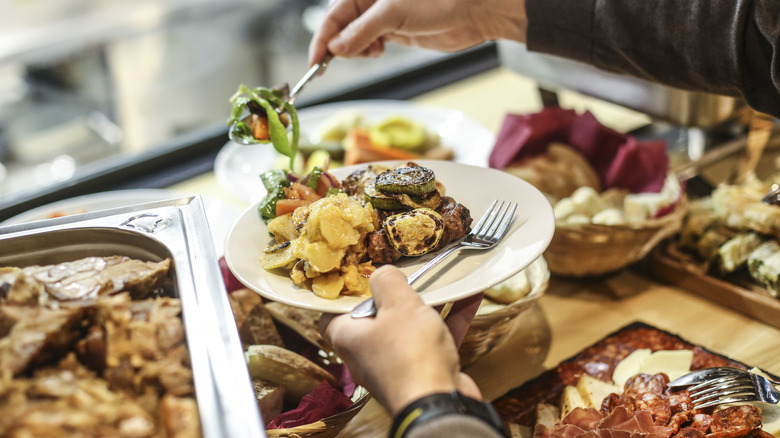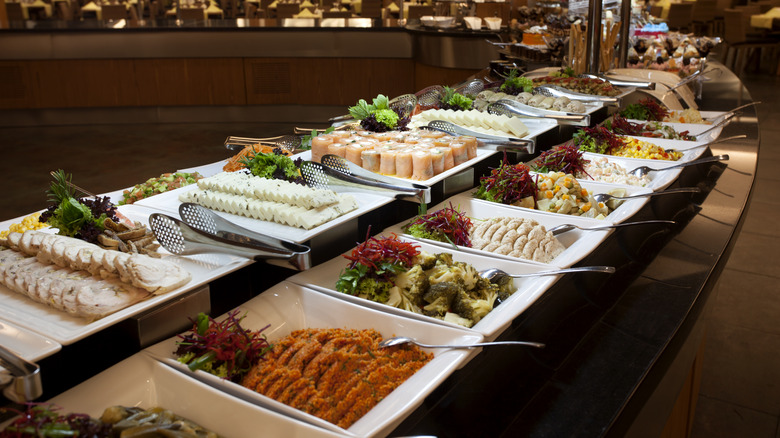Can You Be Kicked Out Of An All-You-Can-Eat Buffet For Eating Too Much?
Buffets invite hungry diners to taste a vast assortment of offerings. From salad bars to seafood and carving stations, plenty of buffet patrons who are eager to get their money's worth no doubt surprise themselves with how much they can eat in a single sitting. But can a buffet kick customers out for eating too much?
All-you-can-eat buffets employ a specific business strategy to increase the number of patrons in an establishment. Since a typical restaurant requires waitstaff to take orders and hand-deliver each plate of food, it can only manage a certain number of customers in a single night. Buffets, on the other hand, largely run on a self-service system and often feature dishes that are designed to be sharable.
With easier food prep and fewer required workers, buffets can serve more meals to more customers while keeping labor costs low enough to make a profit. Of course, this formula requires a fine balance, and every once in a while, a customer may eat far more of the buffet's expensive beef or lobster tail than the restaurant anticipated. Usually, this is offset by other customers who prefer less costly items like chicken or pasta; however, once a customer is inside the buffet, there are very few restrictions a restaurant can implement to limit a particular diner's food access, and kicking a patron out for overeating would undoubtedly be a breach of the implied contract.
What restrictions can a buffet put in place?
While restaurants can't legally remove customers for perceived overeating, the long history of the buffet restaurant has brought certain tactics to light, and there are more covert ways to minimize customer consumption and food waste. Using small serving plates is one common tactic that buffets use to make diners feel as though they've eaten more than they really have. Additionally, staff-operated carving stations limit the amount of meat each customer can get per trip. Placing cheaper, more filling items at the front of the buffet also catches hungry customers' attention, leaving them less hungry for the pricier products.
Some buffets even offer dessert and beverage packages for an additional fee. Las Vegas is home to some of the best all-you-can-eat buffets in its state; the MGM Grand Buffet, in particular, offers separate alcohol packages for customers who prefer to drink, including unlimited beer and wine, Well Liquor, and frozen drinks. Of course, a restaurant must abide by legal limitations that prevent establishments from serving alcohol to intoxicated patrons.
As far as food is concerned, however, any restrictions the buffet plans to enact must be specified before customers consent to dine there. Some buffets offer takeout options, but customers are typically limited to one container and offered a cheaper price. Generally speaking, buffet etiquette dictates (or at least implies) that customers can't take food home.
Always check a buffet's website for info
Many all-you-can-eat sushi buffets charge customers for the rolls they order but don't eat. This helps reduce over-ordering and discourages customers from pushing their limits. If they do, however, these restaurants establish that the customer — not the buffet — will pay for the excess food. As such, customers should note any rules and regulations ahead of time.
Ultimately, a buffet kicking customers out is only a breach of contract if its restrictions are poorly outlined at the time of purchase. While it's nearly impossible for a buffet to define what "too much" food is for a single person, enacting time restrictions for patrons is a reliable safeguard. For example, a company's website will often specify a two-hour time limit as a form of protection.
While these time restrictions are rarely enforced, they give the buffet legal authority to remove patrons who are overstaying and may be taking advantage of the system. These limits also incentivize customers to enjoy their food without trying to snag more than one meal. Therefore, it's worth your while to research a buffet before you visit and plan your dining accordingly.


